OSCAR-QUBE (Optical Sensors based on CARbon materials: QUantum BElgium)
EO
Gravity and Magnetic Fields
Gravity, Magnetic and Geodynamic measurements
Operational (nominal)
Quick facts
Overview
| Mission type | EO |
| Agency | Hasselt University |
| Mission status | Operational (nominal) |
| Launch date | 29 Aug 2021 |
| Measurement domain | Gravity and Magnetic Fields |
| Measurement category | Gravity, Magnetic and Geodynamic measurements |
| CEOS EO Handbook | See OSCAR-QUBE (Optical Sensors based on CARbon materials: QUantum BElgium) summary |
OSCAR-QUBE (Optical Sensors based on CARbon materials: QUantum BElgium)
Launch Mission Status Payload References
Overview
OSCAR-QUBE (Optical Sensors based on CARbon materials: QUantum BElgium) is a scientific experiment designed, built, and operated by students from Hasselt University, Belgium and supported by ESA Education’s Orbit Your Thesis! program. 1)
It is an ambitious experiment that uses quantum technology to perform extremely rapid and precise measurements of the Earth’s magnetic field. The team will use the data collected to create a high-resolution map of the magnetic field around the globe.
The students have been working towards this event since 2020, when they were accepted into ESA Education Office’s Orbit Your Thesis! program. Participating teams are given the life-changing opportunity to design and build a real experiment that is placed onboard the ISS’s ICE Cubes facility, providing them with an incredible educational experience to kick-start their future professions in the space sector.
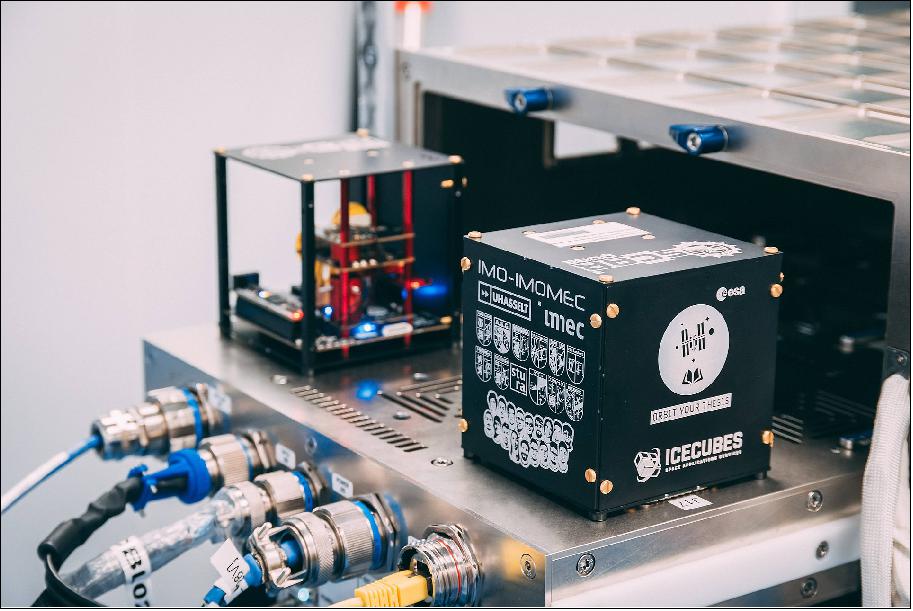
The OSCAR QUBE team managed to design, build, integrate, and test their experiment throughout the ongoing pandemic. One team member remarked, “The toughest [part of the project] was the COVID-19 restrictions we had to work under ... It made us sometimes feel isolated, but keeping the spirit high it made it possible.” Another team member noted, “The best aspect of the project is my team. The spirit we built up and the way we faced challenges all together was very rewarding.” Despite the challenges, team OSCAR-QUBE is ready to launch their experiment to the ISS.
Development Status
• April 21, 2021: From 6 to 8 April 2021, the OSCAR-QUBE student team visited the CubeSat Support Facility, at ESEC, in Belgium, for the vibration test campaign of their ICE Cube experiment, one of the milestones of their participation in ESA Academy’s Orbit Your Thesis! program. 2)
- This program gives Master’s students and PhD candidates the exciting opportunity to fly a scientific experiment of their own design in microgravity conditions on board the International Space Station. In April 2020, the OSCAR-QUBE team, 16 students from Hasselt University in Belgium, were selected to participate. Their goal is to develop a new generation of magnetic field sensors based on quantum working principles, whereby a defect in the crystalline lattice of a diamond can be exploited as a magnetic field probe. Orbit Your Thesis! is supporting them in the development and testing of their experiment, with the aim of launching it to the International Space Station. Once there, it will be integrated into the ICE Cubes Facility, where it will remain for 4 months to conduct its science.
- Before the experiment can be launched, it has to be thoroughly tested on the ground to ensure that it will survive the harsh vibrations produced by the rocket carrying it into orbit, and will safely reach the International Space Station. This is a major milestone for any space object built on Earth, from small ICE Cubes to large spacecraft. In order to conduct the tests, two students from the OSCAR-QUBE team travelled to the CubeSat Support Facility, in Belgium, to make use of the 20 kN shaker for a vibration test campaign.
- During these three days, the OSCAR-QUBE experiment was installed in a custom test set-up prepared by the student team. The experiment was then submitted to three random vibration tests -one in each axis. The test was set up with levels carefully crafted to ensure that the QUBE endured very similar vibrations to those that it will experience when packaged in the cargo ship that will take it, along with astronaut supplies and other science experiments, on its journey to the International Space Station on board the Space X CRS vehicle.
- This was the team’s first ever vibration test, so they were carefully supported throughout the preparation and execution by ESA Education staff. The students adjusted admirably to performing lab work in the current environment of restrictions imposed by COVID -19 prevention measures. Strict social distancing added a twist to the already complex preparations, but the students rose to the challenge, showing a level of adaptability that impressed their ESA Education mentors. The entire experience of planning and running the test campaign has helped the students to acquire valuable skills and knowledge, which will be integral to their future careers as space engineers and scientists.
- Finally, after all the hard work put into the design and manufacturing stages, the OSCAR-QUBE team can now state that they have also successfully completed a comprehensive vibration test. Their experiment is one step closer to its destination!
• November 27, 2020: The OSCAR-QUBE team, participating in the second edition of the ESA Academy's Orbit Your Thesis! program, successfully passed the Preliminary Design Review this 18th of November. 3)
- The team, composed of students from Hasselt University (Belgium), was selected last March to develop an experiment which aims to map the Earth's magnetic field using the quantum state of the nitrogen vacancies in diamond.
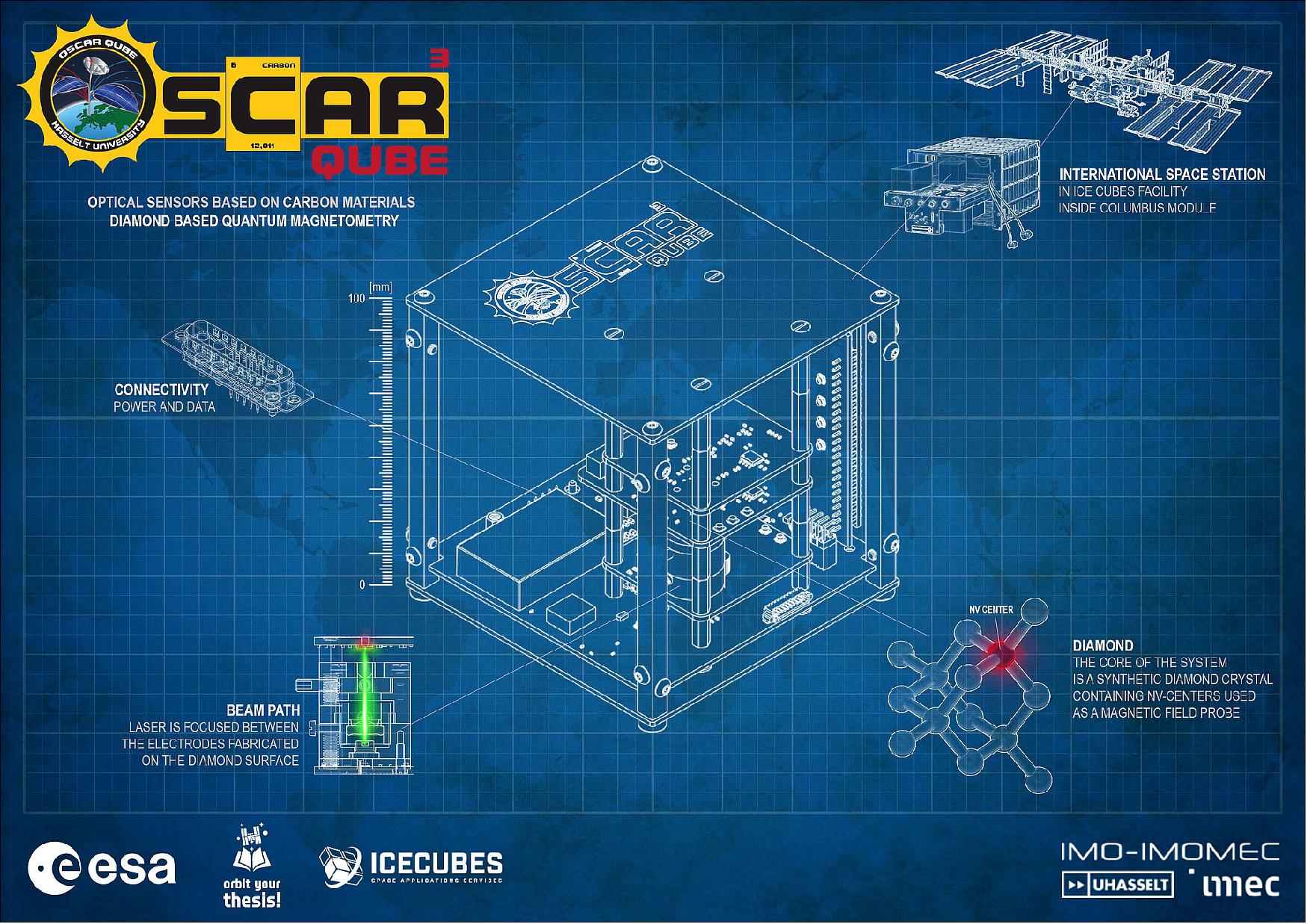
- After having worked hard to complete the numerous deliverables requested during the preliminary design phase, while showing an exemplary attitude to the university to maintain access to the laboratories despite the pandemic, the team delivered a Preliminary Design Review Data Package this summer.
- The review panel, made up of experts from ESA, Space Applications Services and ZARM, then revised the documents and shared mandatory recommendations with the team. These inputs are a valuable aid for the student team, which has to build a payload that meets the International Space Station’s requirements. After exchanges between the team and the experts in order to close all the actions associated to the aforementioned recommendations, the close-out meeting was held last Wednesday, sealing the end of the Preliminary Design Phase.
- This meeting also marked the beginning of the next stage: Phase C, the Detailed Design Phase. During this stage, OSCAR-QUBE will have to freeze the design of its experiment, as well as the processes for the manufacturing, assembly, integration and testing operations, that will be eventually carried out in Phase D.
- The team, which is very proactive, has already manufactured a test bench model to separately test the subsystems. The students are now working on a first assembled model to verify that the design solutions currently selected meet the numerous scientific and technological requirements.
- Once again, the evaluation board congratulates the Team OSCAR-QUBE for the great work!
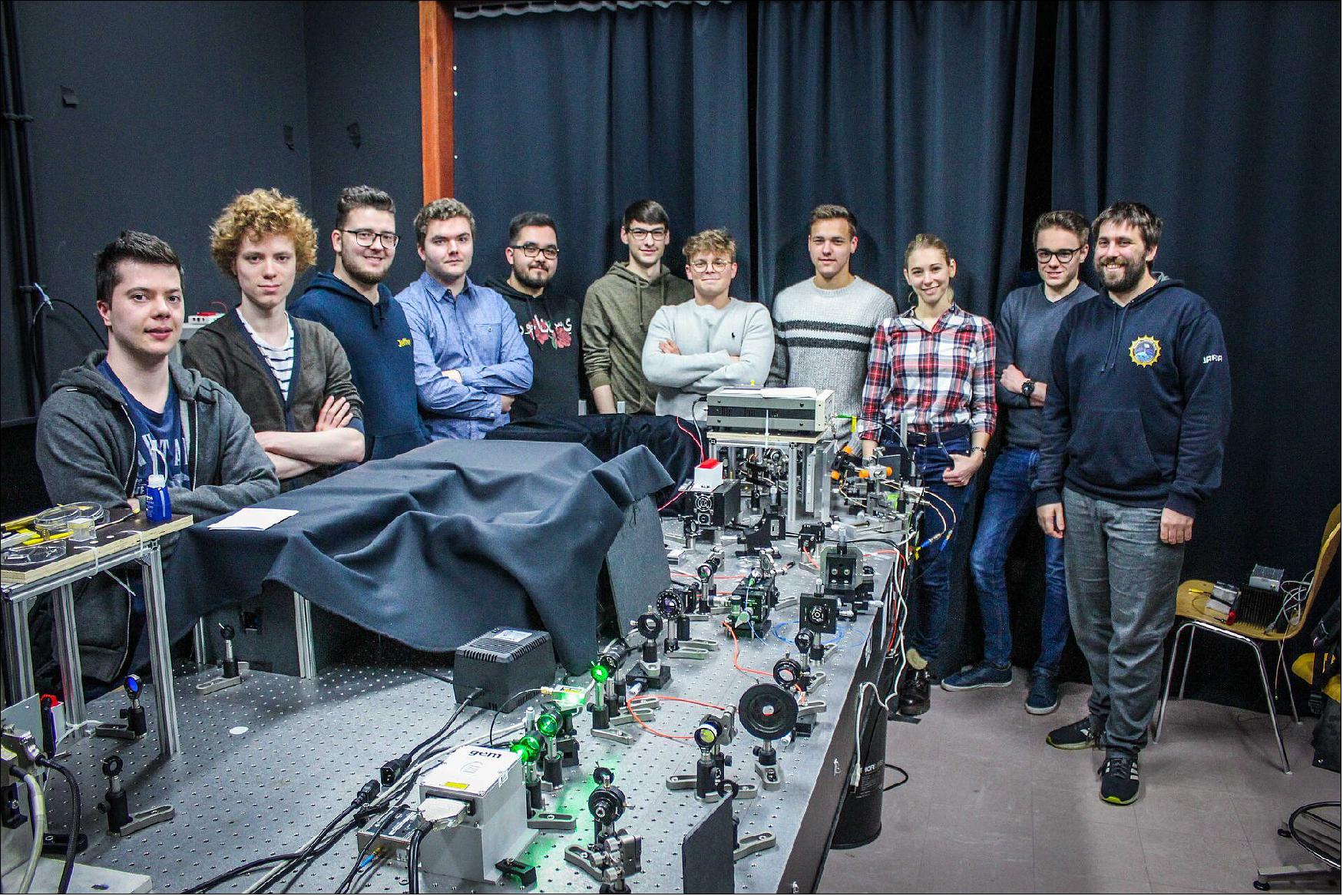
Team OSCAR-QUBE believe emerging quantum sensing techniques can change the way we see the world today. By developing new types of sensors that employ quantum detection principles based on diamond, they are developing magnetic field sensors with high sensitivity, wide dynamic range and a fast response to changes in the magnetic field, and that provide stable operation in harsh conditions. 4)
Launch
The OSCAR-QUBE is a passenger payload (a 1U CubeSat) on the CRS-23 (Commercial Resupply Services) mission of SpaceX to the ISS, launched on 29 August 2021 at 7:14 UTC from Launch Complex 39A (LC-39A) at the agency’s Kennedy Space Center in Florida. Dragon is packed with more than 2,200 kg of supplies, scientific experiments and hardware, including a new robotic arm that will be tested inside the space station's Bishop Airlock. 5) 6)
Orbit: Near circular orbit, altitude of ~ 400 km, inclination = 51.6º, period of~92 minutes.
Cargo Dragon is now on course to rendezvous with the International Space Station for a Monday (30 August) docking.
Mission Status
• November 11, 2021: The student team OSCAR-QUBE, who currently have their diamond-based quantum magnetometer aboard the International Space Station (ISS) as part of the Orbit Your Thesis! (OYT!) program, was awarded the Hans von Muldau Team Award at the International Astronautical Congress (IAC) 2021 in Dubai. 7)
- Back in September of this year, the OSCAR-QUBE team was celebrating a successful hardware integration into the ISS’s ICE Cubes facility by ESA astronaut Thomas Pesquet. This was done in part of the ESA Education Office’s OYT! program, in which the students must propose their own experiment to be launched to the ISS. The team managed to do this at an impressive pace considering the scientific and safety requirements their experiment needed to fulfill.
- Fast forward to today and the student team behind experiment OSCAR-QUBE presented at both the World Expo and the IAC in Dubai. Their hard work has been rewarded with the Hans von Muldau team award for the best team project. It shows that the “hands-on” approach that ESA Academy offers students leads to fantastic experiences which form the foundations of their future careers in the space sector and steers them to actively make contributions to the advancement of science and technology.
- It’s not the first time that ESA Academy teams receive this award. In 2015 and 2017, the FELDs and STAR experiments from Drop Your Thesis! campaigns also received this coveted prize!
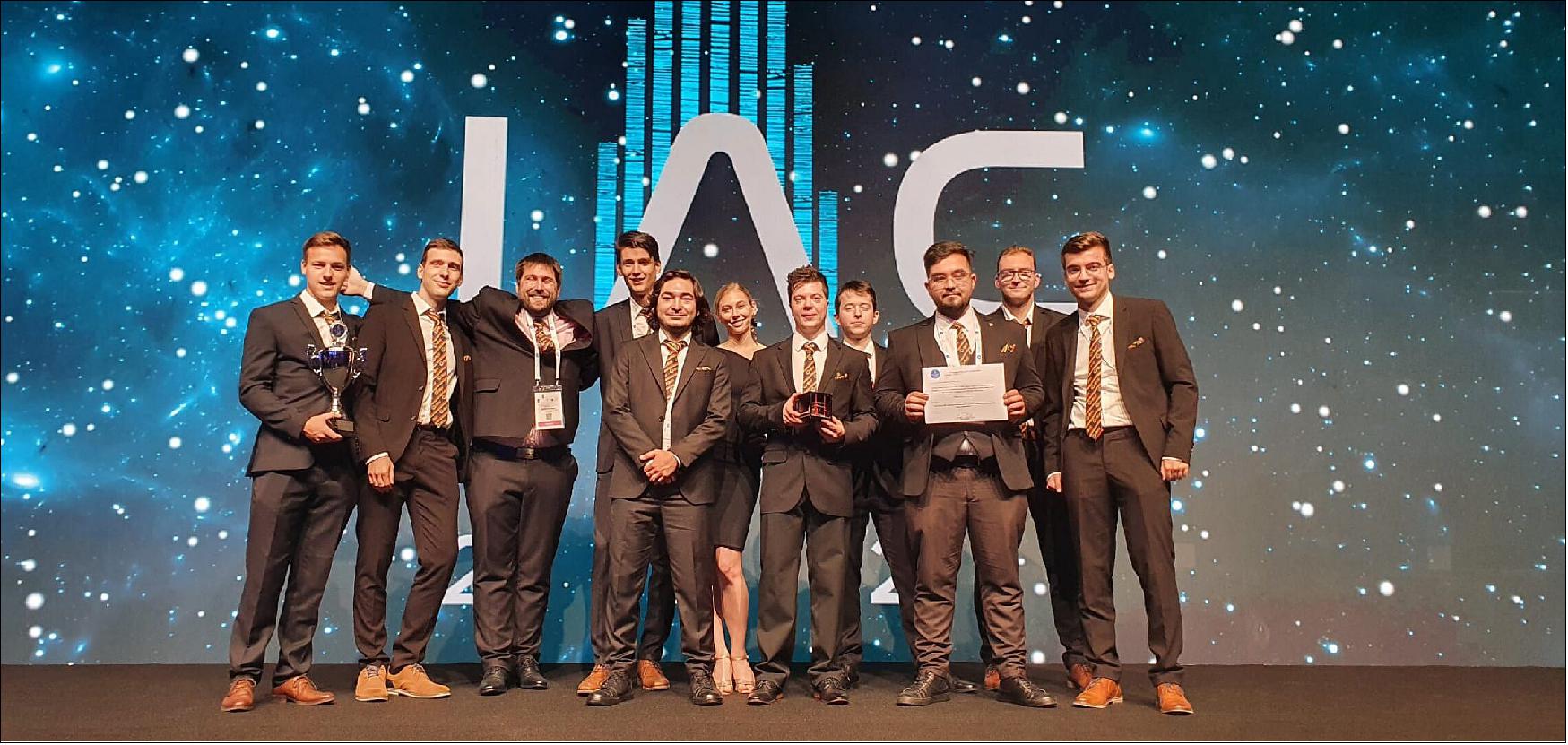
• September 3, 2021: The student team behind experiment OSCAR-QUBE are celebrating yesterday after their hardware was integrated into the International Space Station’s ICECubes facility by ESA astronaut Thomas Pesquet! 8)
- The OSCAR-QUBE experiment uses diamond-based quantum technology to perform extremely rapid and precise magnetic field measurements, allowing the team to create a high-resolution map of these fields from Low Earth Orbit. It is part of ESA Education Office’s Orbit Your Thesis! program, where student teams produce their own experiments to be installed onboard the International Space Station. This “learning by doing” approach not only gives students fantastic experiences to form the foundations of their future careers in the space sector but also actively contributes to the advancement of science and technology.
- The ICECubes facility will be OSCAR-QUBE’s home for the next eight months, but the immediate next step is for the students to begin a series of test routines designed to ensure that the experiment is working properly after its turbulent ride into space. Once full functionality has been confirmed the team will switch the equipment to collection mode, providing the students with valuable data to analyze.
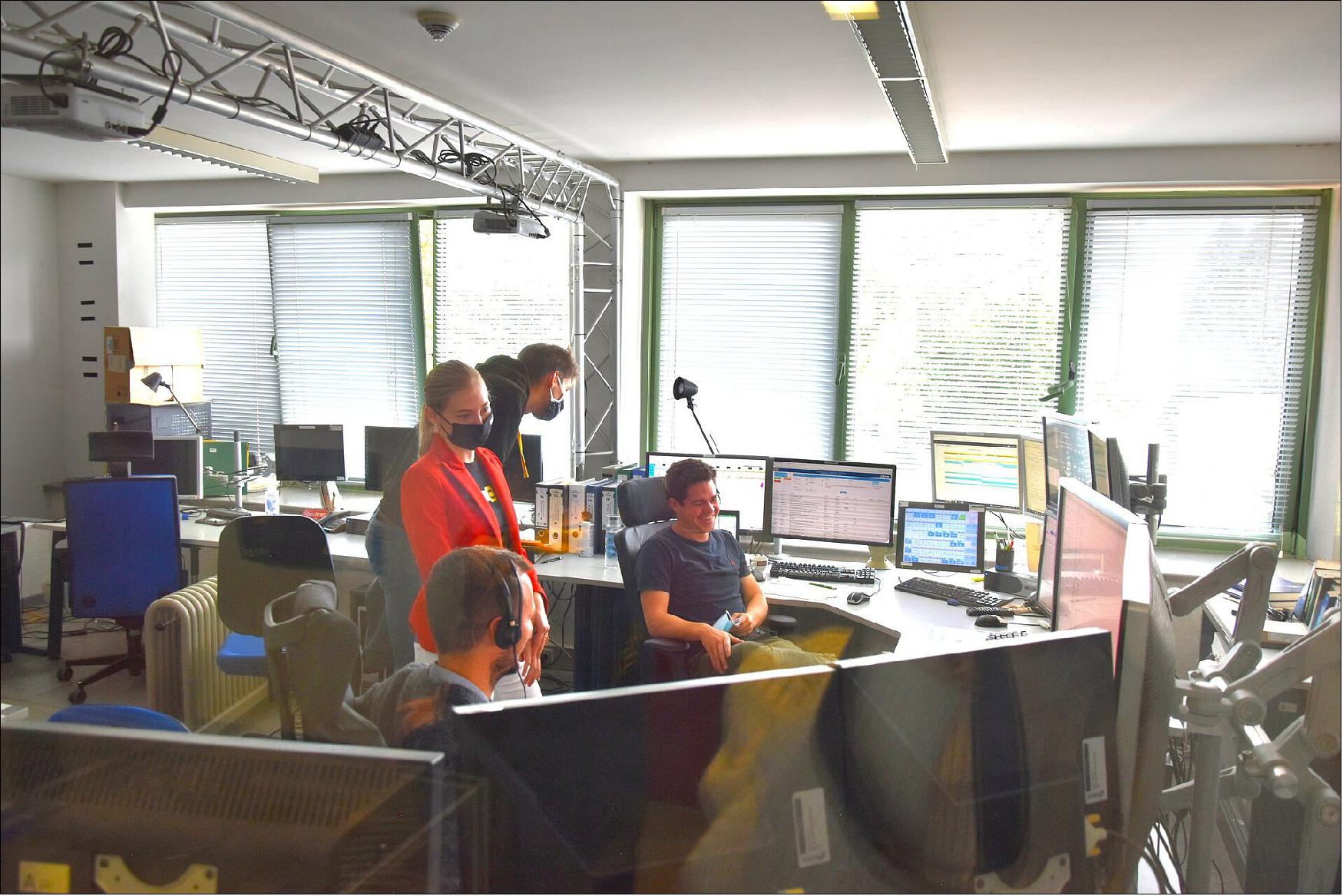
Sensor Complement
OSCAR-QUBE Payload
OSCAR-QUBE is a team of 15 students from Hasselt University (Belgium) developing a new generation of magnetic field sensors working on quantum principles. This type of sensor is based on Photoelectric Detection of Magnetic Resonance (PDMR) of Nitrogen-Vacancy (NV) centers. This defect in the crystalline lattice of the diamond can be exploited as a magnetic field probe with unique properties such as sub-picotesla sensitivity, wide dynamic range (fT - mT), and fast response to the changes in the magnetic field (<200 ns). Because NV centers are located in the diamond lattice along four different orientations, the sensor can be used for vector magnetometry. The resulting device can be used for many space and terrestrial applications. 9)
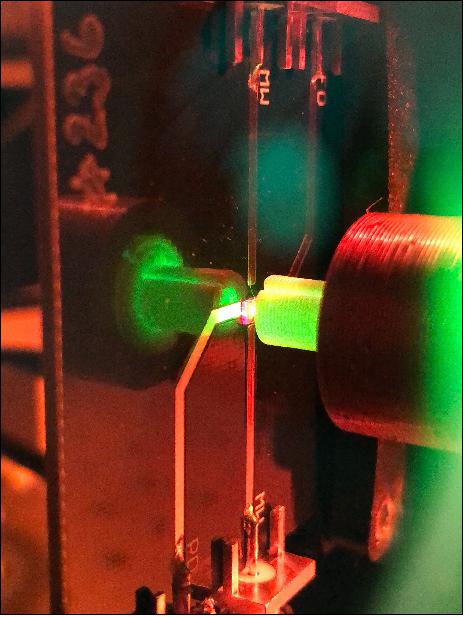
Quantum technologies - The next frontier in technological advancement is not only quantum computing or encryption. Quantum sensing technologies enable the measurement of physical quantities using quantum properties of materials. This results in “digital” drift-free measurements. It enables the accurate measurement of external fields, with high sensitivity, across a broad frequency spectrum. Further development of this technology and the widespread use of quantum sensing will enrich both space and terrestrial applications, such as, for example, navigation, communication or healthcare, and might lead to new discoveries and space exploration.
How does the sensor work? The core of the sensor consists of a single crystal diamond containing the Nitrogen-Vacancy (NV) centers – paramagnetic point defects in a crystallographic lattice. Traditionally the NV center spin states are read optically. However, in their experiment, OSCAR-QUBE is using a photoelectric readout spin state method that allows for miniaturization of the device, which is beneficial for space applications. To make PDMR possible, electrodes and a microwave antenna are fabricated on top of the diamond surface. Green laser light is then shined on the diamond in between the electrodes to induce a photocurrent, followed by an applied resonant microwave frequency resonant with NV spin transitions. By observing the changes in the photoelectric signal, the team is able to determine the intensity and orientation of the external magnetic field.
OSCAR-QUBE’s mission is to measure the magnetic field in low Earth orbit (LEO) and evaluate and study contributing sources originating from i.e. Earth’s geodynamo, lithospheric movements, or mineral resource deposits. The characteristics of their device together with large geographical coverage of the ISS will allow the team to acquire a high resolution map of the magnetic field around the globe. Another potential source of a magnetic field is space weather events. Gaining insight into space weather can help mitigate its negative effects on not only onboard satellites but also electronic systems down on Earth. While pursuing these goals, they also aim to prove that their magnetic sensing technology can be used from inside the spacecraft. The sensor’s unique quantum properties can be utilized to decouple the sources located within the ISS by evaluating their characteristic temporal and spatial scales. This can yield technical benefits for future space missions by reducing mass and system complexity while eliminating the need for magnetometers outside the spacecraft.
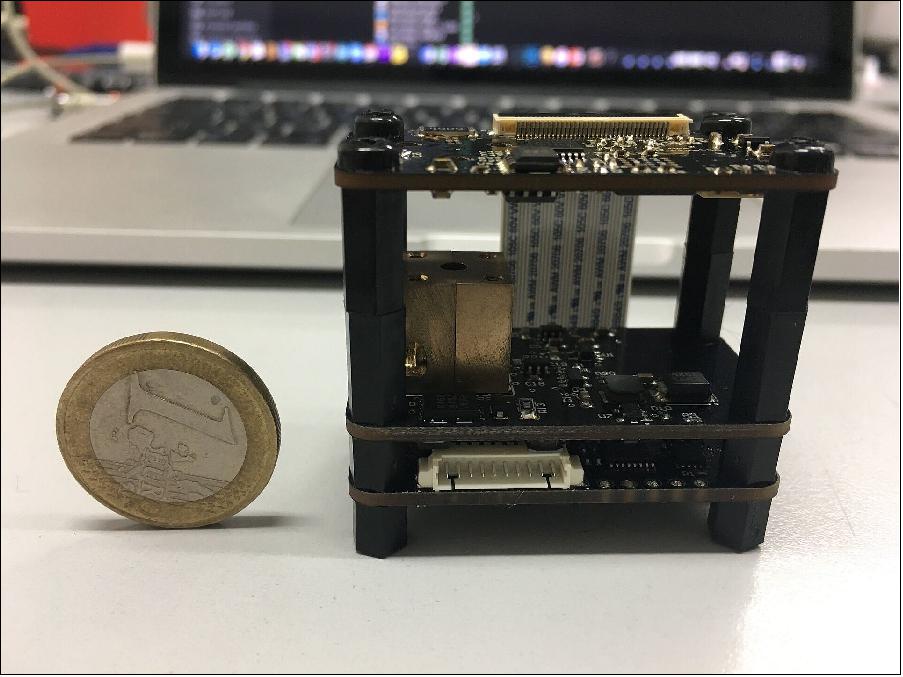
References
1) ”Countdown begins to student experiment OSCAR-QUBE’s journey to the ISS,” ESA Education, 25 August 2021, URL: https://www.esa.int/Education/Orbit_Your_Thesis/
Countdown_begins_to_student_experiment_OSCAR-QUBE_s_journey_to_the_ISS
2) ”OSCAR-QUBE student experiment one step closer to the International Space Station,” ESA, 21 April 2021, URL: https://www.esa.int/Education/Orbit_Your_Thesis/
OSCAR-QUBE_student_experiment_one_step_closer_to_the_International_Space_Station
3) ”OSCAR QUBE pass the Preliminary Design Review,” ESA Education, 27 November 2020, URL: https://www.esa.int/Education/Orbit_Your_Thesis/
OSCAR_QUBE_pass_the_Preliminary_Design_Review?fbclid=IwAR2iEKeGeFU85l1tOZ172Ap-D7aTwCsDL6k7Ds1lY5lMIvq1CDvu7B7-Ogs
4) ”Meet the team: Team OSCAR-QUBE,” ESA Education, 2021, URL: https://www.esa.int/Education/Orbit_Your_Thesis/Meet_the_team_Team_OSCAR-QUBE
5) Amy Thompson, ”SpaceX launches Dragon cargo capsule to space station, nails rocket landing at sea,”Space.com, 29 August 2021, URL: https://www.space.com/
spacex-dragon-crs-23-nasa-cargo-launch-success
6) ”Lift-off for OSCAR-QUBE, now en route to the International Space Station,” ESA Education, 29 August 2021, URL: https://www.esa.int/Education/Orbit_Your_Thesis/
Lift-off_for_OSCAR-QUBE_now_en_route_to_the_International_Space_Station
7) ”Team OSCAR-QUBE awarded the Hans von Muldau Team Award at IAC,” ESA Education, 09 November 2021, URL: https://www.esa.int/Education/Orbit_Your_Thesis/
Team_OSCAR-QUBE_awarded_the_Hans_von_Muldau_Team_Award_at_IAC
8) ”OSCAR-QUBE successfully integrated into the International Space Station’s ICE Cubes facility,” ESA Education, 3 September 2021, URL: https://www.esa.int/Education/Orbit_Your_Thesis/
OSCAR-QUBE_successfully_integrated_into_the_International_Space_Station_s_ICE_Cubes_facility
9) ”Optical Sensors based on CARbon materials: QUantum BElgium,” ESA Education, URL: https://www.esa.int/Education/Orbit_Your_Thesis/Meet_the_team_Team_OSCAR-QUBE
The information compiled and edited in this article was provided by Herbert J. Kramer from his documentation of: ”Observation of the Earth and Its Environment: Survey of Missions and Sensors” (Springer Verlag) as well as many other sources after the publication of the 4th edition in 2002. - Comments and corrections to this article are always welcome for further updates (eoportal@symbios.space).